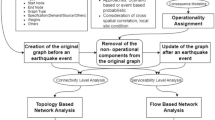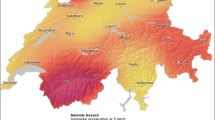Abstract
The Urban Seismic Risk index (USRi) published in a previous article (Carreño et al., Nat Hazards 40:137–172, 2007) is a composite indicator that measures risk from an integrated perspective and guides decision-making for identifying the main interdisciplinary factors of vulnerability to be reduced or intervened. The first step of the method is the evaluation of the potential physical damage (hard approach) as a result of the convolution of the seismic hazard with the physical vulnerability of buildings and infrastructure. Subsequently, a set of social context conditions that aggravate the physical effects is also considered (soft approach). According to this procedure, the physical risk index is evaluated for each unit of analysis from existing loss scenarios, whereas the total risk index is obtained by multiplying the former index by an impact factor using an aggravating coefficient, based on variables associated with the socio-economic conditions of each unit of analysis. The USRi has been developed using the underlying holistic and multi-hazard approach of the Urban Risk Index framework proposed for the evaluation of disaster risk in different megacities worldwide. This article presents the sensitivity analysis of the index to different parameters such as input data, weights and transformation functions used for the scaling or normalization of variables. This analysis has been performed using the Monte Carlo simulation to validate the robustness of this composite indicator, understanding as robustness how the cities maintain the ranking as well as predefined risk level ranges, when compared with the deterministic results of risk. Results are shown for different cities of the world.





Similar content being viewed by others
References
Cardona OD (2001) Estimación Holística del Riesgo Sísmico utilizando Sistemas Dinámicos Complejos. PhD Thesis, Technical University of Catalonia, Barcelona, Spain
Cardona OD (2004) The need for rethinking the concepts of vulnerability and risk from a holistic perspective: a necessary review and criticism for effective risk management. In: Bankoff G, Frerks G, Hilhorst D (eds) Mapping vulnerability: disasters, development and people. Earthscan Publishers, London, pp 37–51
Cardona OD (2006) A system of indicators for disaster risk management in the Americas. In: Birkmann J (ed) Measuring vulnerability to hazards of natural origin: towards disaster resilient societies. UNU Press, Tokyo, pp 189–209
Cardona OD, Barbat AH (2000) El Riesgo Sísmico y su Prevención. Calidad Siderúrgica, Madrid
Carreño ML (2006) Técnicas innovadoras para la evaluación del riesgo sísmico y su gestión en centros urbanos: Acciones ex ante y ex post. PhD Thesis, Technical University of Catalonia, Barcelona, Spain
Carreño ML, Cardona OD, Barbat AH (2005) Seismic risk evaluation for an urban centre. International Conference 250th anniversary of the 1755 Lisbon earthquake, Lisbon
Carreño ML, Cardona OD, Barbat AH (2007) Urban seismic risk evaluation: a holistic approach. Nat Hazards 40:137–172. doi:10.1007/s11069-006-0008-8
de los Andes U (2005) Seismic risk and loss scenarios of Bogotá (in Spanish), Centro de Estudios sobre Desastres y Riesgos CEDERI. Dirección de Prevención y Atención de Emergencias, DPAE, Bogotá
EMI (2006) Megacity Indicators System MIS: Implementation in Metro Manila, 3 cd program of Earthquake and Megacities Inititative EMI, Pacific Disaster Center, ProVention Consortium
ERN (2005) Seismic information system of Manizales–Risk (in Spanish), SISMAN + Riesgo, Evaluación de Riesgos Naturales ERN. National Planning Department, World Bank, Bogota
Gall M (2007) Indices of social vulnerability to natural hazards: a comparative evaluation. Doctoral Thesis, Department of Geography of the University of South Carolina
Garret MJ (1999) Health futures. World Health Organization, Geneva
Hurtado JE, Barbat AH (1998) Monte Carlo techniques in computational stochastic mechanics. Archives of Computational Methods in Engineering 5(1):3–30
ICC/CIMNE (2004) An advanced approach to earthquake risk scenarios with applications to different European towns, WP08 Application to Barcelona, RISK-UE Project
JRC-EC (2002) State-of-the-art report on current methodologies and practices for composite indicator development. Applied Statistics Group, Joint Research Centre, European Commission, Institute for Protection and Security of the Citizen Technological and Economic Risk Management, Ispra, Italy
JRC-EC (2003) First workshop on composite indicators of country performance. Applied Statistics Group, Joint Research Centre, European Commission, Institute for Protection and Security of the Citizen Technological and Economic Risk Management, Ispra, Italy
Munda G (2000) Multicriteria methods and process for integrated environmental assessment. In: Oñate E, Garcia-Sicilia F, Ramallo L (eds) Métodos Numéricos en Ciencias Sociales (MENCIS 2000). CIMNE-UPC, Barcelona
Saaty TL (1980) The analytic hierarchy process. McGraw-Hill Book Co, NY
Saltelli A (2006) The critique of modeling and sensitivity analysis in the scientific discourse. An overview of good practices. Institute for the Protection and Security of the Citizen, European Commission, Luxemburg, ISSN: 1018-5593, ISBN: 92-79-03130
Suarez DC (2007) Development of disaster risk and risk management indicators at urban level for diagnostic and planning in Manizales (in Spanish). M.Sc Thesis, National University of Colombia, Manizales
Acknowledgments
The authors express gratitude to the Inter-American Development Bank (IDB) for the financial support through the Information and Indicators Program for Disaster Risk Management for Latin America and the Caribbean (ATN/JF-7907-RG Operation), to the ProVention Consortium Earthquake and Megacities Initiative (EMI) for the application of the USRi to Metro Manila and Istanbul, and to the Ministry of Education and Science of Spain, PROFIT program: project “Development of new technologies in materials and processes of construction of components oriented to its integration in buildings” (HABITAT 2030) (PSS-380000-2006-10).
Author information
Authors and Affiliations
Corresponding author
Rights and permissions
About this article
Cite this article
Marulanda, MC., Cardona, O.D. & Barbat, A.H. Robustness of the holistic seismic risk evaluation in urban centers using the USRi. Nat Hazards 49, 501–516 (2009). https://doi.org/10.1007/s11069-008-9301-z
Received:
Accepted:
Published:
Issue Date:
DOI: https://doi.org/10.1007/s11069-008-9301-z




